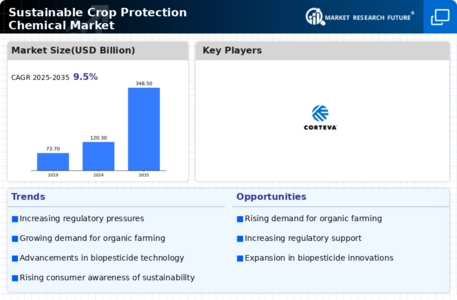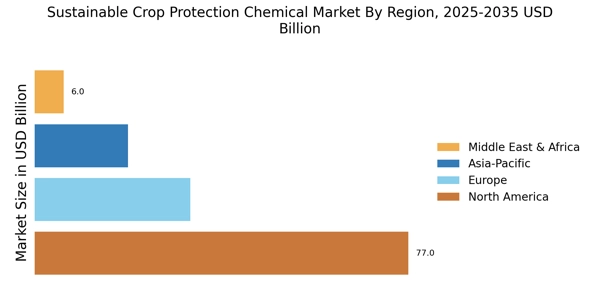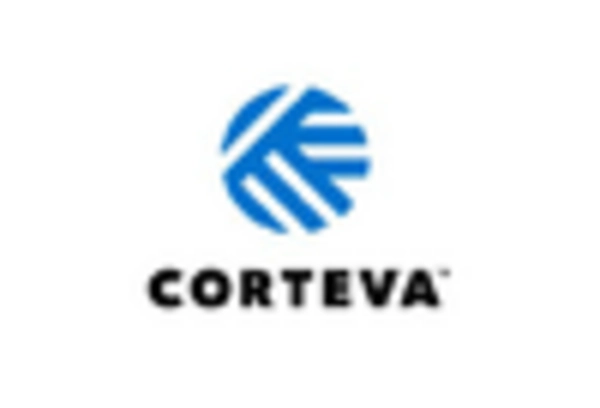Investment in Research and Development
The Sustainable Crop Protection Chemical Market is benefiting from increased investment in research and development (R&D) focused on sustainable agricultural practices. As the need for effective pest management solutions grows, companies are allocating substantial resources to develop innovative and environmentally friendly crop protection chemicals. This investment is crucial for advancing the science behind sustainable practices and ensuring that new products meet both efficacy and safety standards. Recent reports indicate that R&D spending in the agricultural sector has risen by approximately 20% over the past few years, reflecting a commitment to sustainability. Such investments are likely to yield new products that not only address pest issues but also contribute to the overall sustainability of agricultural systems.
Regulatory Support for Sustainable Practices
The Sustainable Crop Protection Chemical Market is significantly influenced by regulatory frameworks that promote sustainable agricultural practices. Governments and international bodies are increasingly implementing stringent regulations aimed at reducing the environmental impact of chemical usage in agriculture. For instance, policies that encourage the adoption of biopesticides and other eco-friendly alternatives are gaining traction. This regulatory support not only fosters innovation but also incentivizes farmers to transition towards sustainable practices. As a result, the market for sustainable crop protection chemicals is expected to expand, with projections indicating a potential growth rate of 8 to 12% over the next few years. Such regulatory measures are crucial in steering the agricultural sector towards more sustainable methodologies.
Technological Innovations in Crop Protection
The Sustainable Crop Protection Chemical Market is witnessing a surge in technological innovations that enhance the efficacy and safety of crop protection solutions. Advancements in biotechnology, such as the development of genetically modified organisms (GMOs) and precision agriculture technologies, are enabling farmers to apply sustainable crop protection chemicals more effectively. These innovations not only improve pest management but also minimize the environmental footprint associated with chemical applications. For example, the integration of drones and satellite imagery in monitoring crop health allows for targeted interventions, reducing the overall quantity of chemicals used. This trend is likely to drive market growth, with estimates suggesting that the adoption of such technologies could lead to a 15% increase in the efficiency of sustainable crop protection practices.
Increasing Consumer Demand for Organic Products
The Sustainable Crop Protection Chemical Market is experiencing a notable shift in consumer preferences towards organic and sustainably produced food. This trend is driven by heightened awareness of health and environmental issues associated with conventional farming practices. As consumers increasingly seek products that are free from synthetic chemicals, the demand for sustainable crop protection solutions is likely to rise. According to recent data, the organic food market has been growing at a compound annual growth rate of over 10%, which in turn propels the need for effective and environmentally friendly pest management solutions. This consumer-driven demand is compelling manufacturers to innovate and invest in sustainable crop protection chemicals that align with organic farming standards, thereby reshaping the market landscape.
Rising Awareness of Environmental Sustainability
The Sustainable Crop Protection Chemical Market is increasingly shaped by a growing awareness of environmental sustainability among stakeholders. Farmers, consumers, and policymakers are becoming more cognizant of the ecological consequences of traditional agricultural practices, leading to a shift towards sustainable alternatives. This heightened awareness is prompting agricultural producers to seek out sustainable crop protection chemicals that align with environmental stewardship goals. Market data indicates that a significant portion of farmers is now prioritizing sustainability in their purchasing decisions, with surveys revealing that over 60% are willing to invest in eco-friendly solutions. This trend is expected to bolster the demand for sustainable crop protection chemicals, as stakeholders recognize the long-term benefits of adopting environmentally responsible practices.


















Leave a Comment